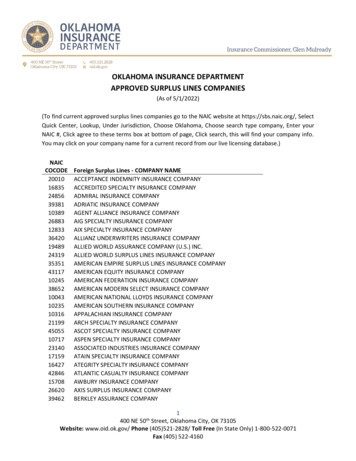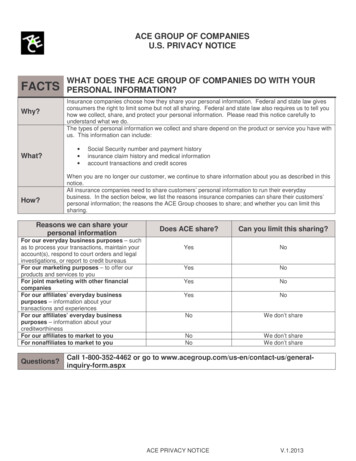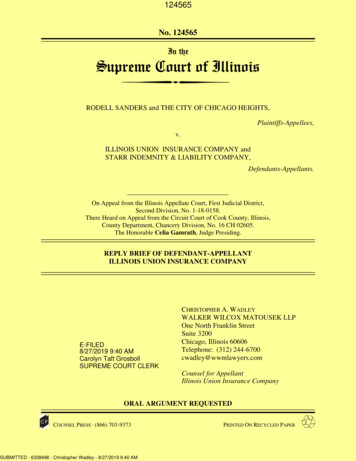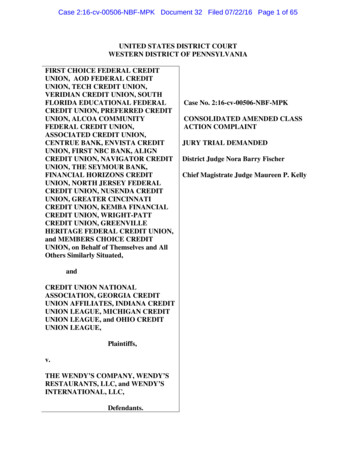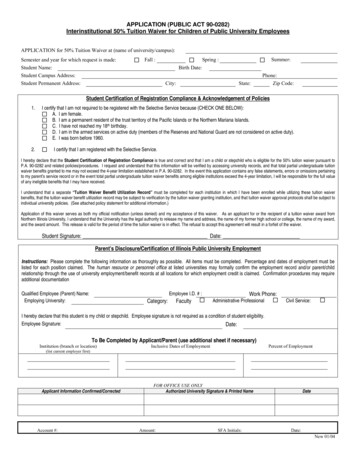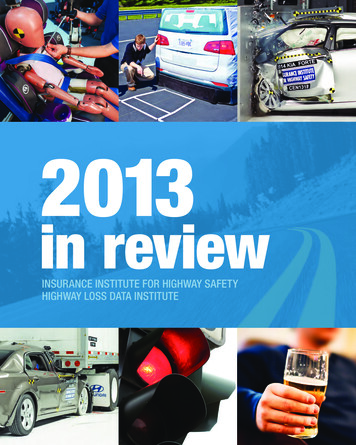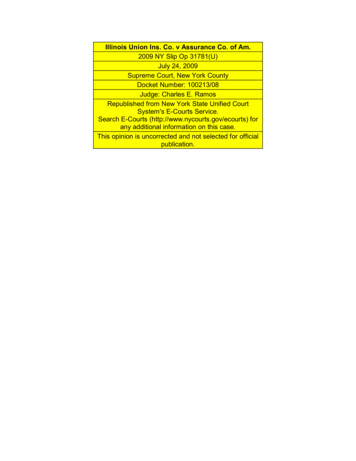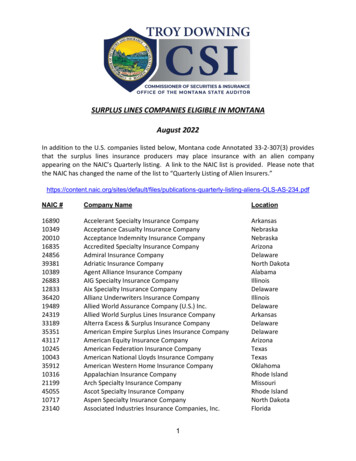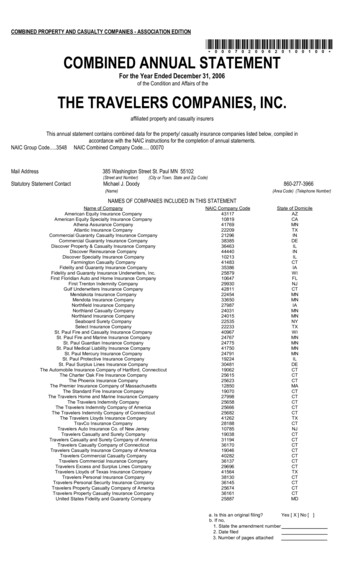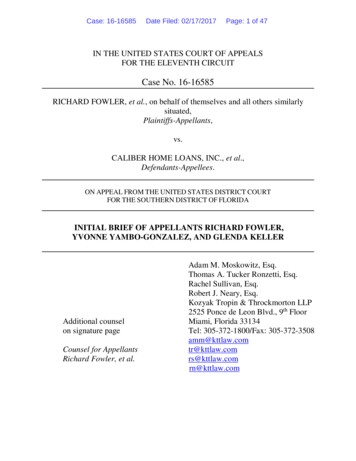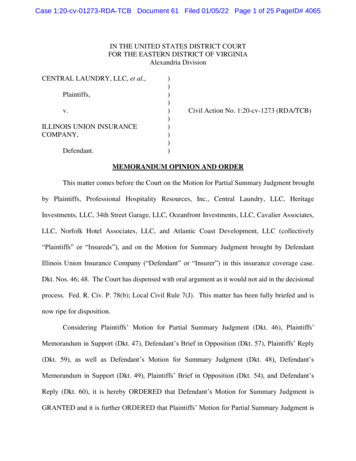
Transcription
Case 1:20-cv-01273-RDA-TCB Document 61 Filed 01/05/22 Page 1 of 25 PageID# 4065IN THE UNITED STATES DISTRICT COURTFOR THE EASTERN DISTRICT OF VIRGINIAAlexandria DivisionCENTRAL LAUNDRY, LLC, et al.,Plaintiffs,v.ILLINOIS UNION INSURANCECOMPANY,Defendant.))))))))))Civil Action No. 1:20-cv-1273 (RDA/TCB)MEMORANDUM OPINION AND ORDERThis matter comes before the Court on the Motion for Partial Summary Judgment broughtby Plaintiffs, Professional Hospitality Resources, Inc., Central Laundry, LLC, HeritageInvestments, LLC, 34th Street Garage, LLC, Oceanfront Investments, LLC, Cavalier Associates,LLC, Norfolk Hotel Associates, LLC, and Atlantic Coast Development, LLC (collectively“Plaintiffs” or “Insureds”), and on the Motion for Summary Judgment brought by DefendantIllinois Union Insurance Company (“Defendant” or “Insurer”) in this insurance coverage case.Dkt. Nos. 46; 48. The Court has dispensed with oral argument as it would not aid in the decisionalprocess. Fed. R. Civ. P. 78(b); Local Civil Rule 7(J). This matter has been fully briefed and isnow ripe for disposition.Considering Plaintiffs’ Motion for Partial Summary Judgment (Dkt. 46), Plaintiffs’Memorandum in Support (Dkt. 47), Defendant’s Brief in Opposition (Dkt. 57), Plaintiffs’ Reply(Dkt. 59), as well as Defendant’s Motion for Summary Judgment (Dkt. 48), Defendant’sMemorandum in Support (Dkt. 49), Plaintiffs’ Brief in Opposition (Dkt. 54), and Defendant’sReply (Dkt. 60), it is hereby ORDERED that Defendant’s Motion for Summary Judgment isGRANTED and it is further ORDERED that Plaintiffs’ Motion for Partial Summary Judgment is
Case 1:20-cv-01273-RDA-TCB Document 61 Filed 01/05/22 Page 2 of 25 PageID# 4066DENIED. For the reasons that follow, judgment must be entered against Plaintiffs’ claims becausePlaintiffs have failed to establish a triable issue of material fact.I. BACKGROUNDA. Factual BackgroundAlthough the parties dispute certain facts, the following facts are uncontested except wherenoted. See Dkt. 47 at 3-9; Dkt. 49 at 2-14.Plaintiffs are the owners and operators of several hospitality, hotel, and restaurantbusinesses located in Norfolk and Virginia Beach, each of which is owned by Gold Key/PHR.Dkt. 1-2 at 2-4 ¶¶ 1-8, 14. Plaintiffs allege the novel coronavirus, SARS-CoV-2, known to causethe COVID-19 infectious disease (“COVID-19”), has and continues to suspend and threatenPlaintiffs’ operations. Id. at 5 ¶15. COVID-19 is a severe acute respiratory syndrome that maycause respiratory illness and inflammation. Dkt. 47 at 4. The virus spreads using people as vectorsand is thought to be primarily transmitted via respiratory droplets but also via contaminated hands,including those of asymptomatic carriers of the disease, and contaminated surfaces. Id. at 5. TheGovernor of Virginia labeled COVID-19 as a “communicable disease of public health threat” asdefined in § 44-146.16 of the Code of Virginia and a “disaster” as defined in § 44-146.16 of theCode of Virginia. Id. at 210-11. Furthermore, the Governor determined that a “substantialnumber” of individuals with the disease are asymptomatic. Id. at 254.Plaintiffs sought insurance coverage from Defendant for income losses and extra costsrelated to the partial suspension of their operations as well as the costs expended to remediate thepresence and future threat of COVID-19. They sought coverage under Premises Pollution LiabilityPortfolio Insurance Policy number PPI G27840620 001 (“Policy”), which Defendant issued toPlaintiffs covering the period from April 18, 2016 to April 18, 2021. Id. at 29. Plaintiffs had over2
Case 1:20-cv-01273-RDA-TCB Document 61 Filed 01/05/22 Page 3 of 25 PageID# 4067100 employees test positive for COVID-19 while working across seven locations in Virginia—each of which is considered a “covered location” under the Policy. Dkt. 47 at 7; Dkt. 57 at 5. Allparties agree that Plaintiffs’ claim falls within the Policy period.In a letter to Defendant from Plaintiffs, dated March 20, 2020, Plaintiffs notified Defendantof a claim for “business interruption.” Dkt. 1-2 at 322-23. In that letter, Plaintiffs attributed the“business interruption” to a March 17, 2020 notice from the Governor of Virginia declaring thespread of COVID-19 virus a public health emergency, which required Plaintiffs to “partiallysuspend business operations.” Id. at 323. On April 9, 2020, Defendant provided a response letterto Plaintiffs denying coverage under the Policy because the claim “d[id] not involve a ‘pollutioncondition or ‘an indoor environmental condition,’” and as a result, “coverage for ‘businessinterruption’ is not triggered.” Dkt. 47-9 at 4. A letter to Defendant from Plaintiffs, dated April17, 2020, included additional “covered locations” for which Plaintiffs sought compensation for“loss” under the Policy. Id. at 332.The definitions in the Policy are extensive and interrelated. For this reason, this Courtsummarizes the relevant definitions undergirding the arguments presented in the cross-motions forsummary judgment.Plaintiffs generally allege that COVID-19 was a “pollution condition” under the Policy andthat they are entitled to compensation under the Policy for losses sustained therefrom at each oftheir “covered locations” (those locations covered under the terms of the Policy). “Pollutioncondition” is defined in relevant part as:The discharge, dispersal, release, escape, migration, or seepage of any solid, liquid,gaseous or thermal irritant, contaminant, or pollutant, including soil, silt,sedimentation, smoke, soot, vapors, fumes, acids, alkalis, chemicals,electromagnetic fields (EMFs), hazardous substances, hazardous materials, wastematerials, “low-level radioactive waste”, “mixed waste” and medical, red bag,3
Case 1:20-cv-01273-RDA-TCB Document 61 Filed 01/05/22 Page 4 of 25 PageID# 4068infectious or pathological wastes, on, in, into, or upon land and structuresthereupon, the atmosphere, surface water, or groundwater.Dkt. 1-2 at 39.The Policy generally indemnifies Plaintiffs for up to 5,000,000 per “pollution condition”with a 10,000,000 aggregate cap for “all pollution conditions” in excess of a 50,000 self-insuredretention payment per “pollution condition.” Id.; Dkt. 49 at 2-3. A three-day deductible periodalso applies to each “pollution condition,” whereby Defendant is not required to cover liabilitycosts associated with the “pollution condition” for three days following the occurrence of said“pollution condition.” Dkt. 1-2 at 29.There exist three relevant insuring agreements under which Plaintiffs seek compensationfrom Defendant due to their assertion that COVID-19 qualifies as a “pollution condition”: FirstParty Remediation Costs Coverage (“Coverage A”); First-Party Emergency Response Coverage(“Coverage B”); and Supplemental Coverage – Loss of Rental Income (“SupplementalCoverage”). Each of the three coverages applies to “Loss” emanating in one way or another fromthe negative impact of a “pollution condition.”Coverage A requires that the “pollution condition” exist “on, at[,] under or migrating froma ‘covered location.’” Id. at 32. “Loss” under Coverage A includes “first-party remediation costs”which are defined as “reasonable necessary ‘remediation costs’ incurred by an ‘insured’ resultingfrom the discovery of a ‘pollution condition’ .” “Remediation costs” are those “expensesincurred to investigate, quantify, monitor, remove, dispose, treat, neutralize, or immobilize‘pollution conditions’ to the extent required by ‘environmental law’ in the jurisdiction of such‘pollution conditions’ .” “Environmental law” is defined as:any Federal, state, commonwealth, municipal or other local law, statute, ordinance,rule, guidance document, regulation, and all amendments thereto (collectivelyLaws), including voluntary cleanup or risk-based corrective action guidance, or thedirection of an “environmental professional” acting pursuant to the authority4
Case 1:20-cv-01273-RDA-TCB Document 61 Filed 01/05/22 Page 5 of 25 PageID# 4069provided by any such Laws, along with any governmental, judicial oradministrative order or directive governing the liability or responsibilities of the“insured” with respect to a “pollution condition” or “indoor environmentalcondition”.Id. at 36.Coverage A “Loss” also includes “business interruption loss” which means, as relevanthere, “Business income” which the Policy defines as “Net profit or loss . . . that would have beenrealized had there been no ‘business interruption’” id. at 35, or “extra expense” which the Policydefines as:costs incurred by the “insured” due to a “pollution condition” or “indoorenvironmental condition” that are necessary to avoid or mitigate any “businessinterruption”. Such costs must be incurred to actually minimize the amount offoregone “business income” that would otherwise be covered pursuant to thisPolicy.Id. at 37.“Business interruption” in turn is defined as:the necessary partial or complete suspension of the “insured’s” operations at a“covered location” for a period of time, which is directly attributable to a “pollutioncondition” or “indoor environmental condition” to which Coverage A of this Policyapplies. Such period of time shall extend from the date that the operations arenecessarily suspended and end when such “pollution condition” or “indoorenvironmental condition” has been remediated to the point at which the “insured’s”normal operations could reasonably be restored.Id. at 35.Coverage B requires that the “pollution condition” exist “on, at[,] under or migrating froma ‘covered location.’” Id. at 32. “Loss” under Coverage B includes “emergency response costs,”which are defined to include:first-party remediation costs’ incurred within seven (7) days following thediscovery of a “pollution condition” in order to abate or respond to an imminentand substantial threat to human health or the environment arising out of [a]“pollution condition” on, at, under or migrating from a “covered location” provided such “emergency response costs” are reported to the Insurer within5
Case 1:20-cv-01273-RDA-TCB Document 61 Filed 01/05/22 Page 6 of 25 PageID# 4070fourteen (14) days of when [the Insured] first became aware of such “pollutioncondition” .Id. at 35, 37.Lastly, under the Supplemental Coverage, the Policy provides compensation to the Insuredfor “the actual ‘loss of rental income’ . . . resulting from a necessary period of ‘suspension’ arisingout of a ‘pollution condition’ on, at or under . . . a ‘covered location’ . . . .” Id. at 61-62. “Lossof rental income” is defined as “the total, reasonable anticipated rental fees owed to the ‘insured’from tenant occupancy due to the ‘suspension’ of a rented ‘covered location’.” Id. at 62.“Suspension” occurs when “part of, or all of, a rented ‘covered location’ is rendered untenantable. . . due to a ‘pollution condition’ on, at or under . . . such ‘covered location’, which results in firstparty ‘remediation costs’.” Id.B. Procedural BackgroundOn September 18, 2020, Plaintiffs filed their complaint against Defendant in the CircuitCourt for the City of Virginia Beach. The Complaint requests a declaratory judgment as toamounts owed by Defendant to Plaintiffs under the Policy, seeking 11,408,899 in “businessinterruption losses” and 129,554 in “extra expense” and asserting a “bad faith” breach of contractclaim. Dkt. 1-2 at 24 ¶104. On October 28, 2020, Defendant properly filed a notice of removal tothis Court, which jurisdiction this Court accepted as proper under both 28 U.S.C. § 1332(a) and28 U.S.C. § 1441(b). Dkt. 1.On December 11, 2020, Defendant filed an Answer to Plaintiffs’ Complaint and itsAffirmative Defense. Dkt. 10. This Court then issued a scheduling order to begin discovery andthe final pretrial conference was set for June 17, 2021. Dkt. 11. At the final pre-trial conference,this Court set trial for March 1, 2022. Dkt. 34.6
Case 1:20-cv-01273-RDA-TCB Document 61 Filed 01/05/22 Page 7 of 25 PageID# 4071Cross-motions for summary judgment and attendant briefs were filed by the parties onOctober 25, 2021. Dkt. Nos. 46-49. In their Memorandum in Support of Motion for PartialSummary Judgment, Plaintiffs argue they are entitled to partial summary judgment as to theexistence of a legitimate claim of losses directly attributable to a “pollution condition” under thePolicy and that the issue of damages is for a trier of fact to make. Dkt. 47. On the other hand, inDefendant’s Memorandum in Support of Motion for Summary Judgment, Defendant argues theyare entitled to summary judgment and that the case should be dismissed on the grounds that thereis no genuine dispute as to any material fact related to COVID-19 virus constituting a “pollutioncondition” under the Policy and even if COVID-19 qualified as a “pollution condition,” Plaintiffshave not presented a genuine dispute as to any material fact related to losses claimed under thePolicy. Dkt. 49 at 16-31. As a follow-on to their core argument, Defendant maintains that thereis no cognizable basis, as a matter of law, for a bad faith claim based on Defendant’s alleged breachof contract given no liability existed under the Policy in the first instance. Id. at 31-34.II. STANDARD OF REVIEWUnder Federal Rule of Civil Procedure 56, “[s]ummary judgment is appropriate only if therecord shows ‘that there is no genuine dispute as to any material fact and the movant is entitled tojudgment as a matter of law.” Hantz v. Prospect Mortg., LLC, 11 F. Supp. 3d 612, 615 (E.D. Va.2014) (quoting Fed. R. Civ. P. 56(a)).“A material fact is one ‘that might affect the outcome of the suit under the governing law.’A disputed fact presents a genuine issue ‘if the evidence is such that a reasonable jury could returna verdict for the non-moving party.’” Id. at 615-16 (quoting Spriggs v. Diamond Auto. Glass, 242F.3d 179, 183 (4th Cir. 2001)). The moving party bears the “initial burden to show the absence ofa material fact.” Sutherland v. SOS Intern., Ltd., 541 F. Supp. 2d 787, 789 (E.D. Va. 2008) (citingCelotex Corp. v. Catrett, 477 U.S. 317, 325 (1986)). “Once a motion for summary judgment is7
Case 1:20-cv-01273-RDA-TCB Document 61 Filed 01/05/22 Page 8 of 25 PageID# 4072properly made and supported, the opposing party has the burden of showing that a genuine disputeexists.” Id. (citing Matsushita Elec. Indus. Co. v. Zenith Radio Corp., 475 U.S. 574, 586-87(1986)).On summary judgment, a Court reviews the evidence in the light most favorable to the nonmoving party. McMahan v. Adept Process Servs., Inc., 786 F. Supp. 2d 1128, 1134-35 (E.D. Va.2011) (citing Rossignol v. Voorhaar, 316 F.3d 516, 523 (4th Cir. 2003)). Here, Plaintiffs andDefendant have each filed cross-motions for summary judgment. Therefore, “we consider eachmotion separately on its own merits to determine whether either of the parties deserves judgmentas a matter of law.” Bacon v. City of Richmond, Va., 475 F.3d 633, 638 (4th Cir. 2007) (internalquotation marks omitted). Moreover, in considering the motion for summary judgment filed byPlaintiffs, the facts and all reasonable inferences are accordingly drawn in Defendant’s favor. Onthe other hand, in considering the motion for summary judgment initiated by Defendant, the factsand all reasonable inferences are accordingly drawn in Plaintiffs’ favor. Jacobs v. N.C. Admin.Office of the Courts, 780 F.3d 562, 570 (4th Cir. 2015) (quoting Tolan v. Cotton, 572 U.S. 650,657 (2014)). This is a “fundamental principle” that guides a Court as it determines whether agenuine dispute of material fact within the meaning of Rule 56 exists. Id. “[A]t the summaryjudgment stage[,] the [Court’s] function is not [it]self to weigh the evidence and determine thetruth of the matter but to determine whether there is a genuine issue for trial.” Anderson v. LibertyLobby, Inc., 477 U.S. 242, 249 (1986).A factual dispute alone is not enough to preclude summary judgment. “[T]he mereexistence of some alleged factual dispute between the parties will not defeat an otherwise properlysupported motion for summary judgment; the requirement is that there be no genuine issue ofmaterial fact.” Anderson, 477 U.S. at 247-48. And a “material fact” is one that might affect theoutcome of a party’s case. Id. at 248; JKC Holding Co. v. Wash. Sports Ventures, Inc., 264 F.3d8
Case 1:20-cv-01273-RDA-TCB Document 61 Filed 01/05/22 Page 9 of 25 PageID# 4073459, 465 (4th Cir. 2001). The substantive law determines whether a fact is considered “material,”and “[o]nly disputes over facts that might affect the outcome of the suit under the governing lawwill properly preclude the entry of summary judgment.” Anderson, 477 U.S. at 248; HoovenLewis v. Caldera, 249 F.3d 259, 265 (4th Cir. 2001). A “genuine” issue concerning a “materialfact” arises when the evidence is sufficient to allow a reasonable jury to return a verdict in the nonmoving party’s favor. Anderson, 477 U.S. at 248.III. ANALYSISGiven the factual record on summary judgment, it is necessary to determine whethersummary judgment is appropriate as to Plaintiffs’ and Defendant’s claims. Because the claimsmade in Defendant’s brief in support of summary judgment cover the claim made in Plaintiffs’brief supporting partial summary judgment, this Court will evaluate the cross-motions byexamining the assertions made by Defendant in Defendant’s brief supporting summary judgment.A. COVID-19 and “Pollution Condition”Plaintiffs assert that COVID-19 constitutes a “pollution condition” under the Policy whileDefendant argues the opposite. The Court must first review the applicable law of the forum inwhich the claim arises. As Plaintiffs rightly outline in their brief, Virginia law applies. Dkt. 47 at10. It is a fundamental principle that a federal court presiding over a case with jurisdiction via thediversity statute, as here, is obliged to apply the substantive law directed by the forum’s choiceof-law rules. See Erie R. Co. v. Tompkins, 304 U.S. 64, 78 (1938); see also Klaxon Co. v. StentorElec. Mfg. Co., 313 U.S. 487, 496 (1941). Virginia’s choice-of-law rules apply the lex locicontractus rule whereby the law of the state where the contract was formed governs. Woodson v.Celina Mut. Ins. Co., 211 Va. 423 (1970). The place of contracting “is determined by the placewhere the final act necessary to make the contract binding occurs.” O’Ryan v. Dehler Mfg. Co.,99 F. Supp. 2d 714, 718 (E.D. Va. 2000). Here, the Policy was executed by an authorized9
Case 1:20-cv-01273-RDA-TCB Document 61 Filed 01/05/22 Page 10 of 25 PageID# 4074representative of the lead policyholder, Professional Hospitality Resources, Inc., located inVirginia Beach, Virginia and was therefore issued and delivered in Virginia. Dkt. 1-2 at 29, 31;see Allied Prop. & Cas. Ins. Co. v. Zenith Aviation, Inc., 336 F. Supp. 3d 607, 610 (E.D. Va. 2018).As such, Virginia contract interpretation law applies.Under Virginia law, contract interpretation is a question of law governed by the ordinaryrules of contract interpretation. Penn Nat’l Mut. Cas. Ins. Co. v. Block Roofing Corp., 754 F. Supp.2d 819, 823 (E.D. Va. 2010); Bohreer v. Erie Ins. Grp., 475 F. Supp. 2d 578, 584 (E.D. Va. 2007).The insured bears the burden of establishing a prima facie case that they have a claim under theircoverage policy such that the insured must “bring himself within the policy.” TRAVCO Ins. Co.v. Ward, 715 F. Supp. 2d 699, 706 (E.D. Va. 2010) (quoting Maryland Cas. Co. v. Cole, 156 Va.707, 715 (1931)). The burden is onerous only to the degree “it clearly appears from the initialpleading the insurer would not be liable under the policy contract for any judgment based upon theallegations.” Res. Bankshares Corp. v. St. Paul Mercury Ins. Co., 407 F.3d 631, 636 (4th Cir.2005). In the event the insured meets his initial burden, the burden shifts to the insurer to raise itsaffirmative defenses, including applying any relevant policy exclusions. TRAVCO Ins. Co., 715F. Supp. 2d at 706.Courts applying Virginia contract interpretation principles to an insurance policy must firstevaluate whether the language of the policy is “clear and unambiguous.” Transcontinental Ins.Co. v. RBMW, Inc., 262 Va. 502, 512 (2001); Schneider v. Continental Cas. Co., 989 F.2d 728,733 (4th Cir. 1993). If so, courts must “give the language its plain and ordinary meaning andenforce the policy as written.” Penn Nat’l Mut. Cas. Ins. Co., 754 F. Supp. 2d at 823. On theother hand, if the court determines the language is ambiguous as a matter of law, Virginia lawapplies rules of construction in favor of a reading that “grants coverage, rather than one which10
Case 1:20-cv-01273-RDA-TCB Document 61 Filed 01/05/22 Page 11 of 25 PageID# 4075withholds it.” Gov’t Emps. Ins. Co. v. Moore, 266 Va. 155, 165 (2003). But establishing ambiguityis a high standard. A court will not find ambiguity “merely because the parties disagree as to themeaning of the terms used.” TM Delmarva Power, LLC v. NCP of Va., LLC, 263 Va. 116, 119(2002). Courts must not “strain to find ambiguities . . . or examine certain specific words orprovisions in a vacuum, apart from the policy as a whole.” Res. Bankshares Corp., 407 F.3d at636 (internal citation omitted).Moreover, courts applying Virginia contract interpretation law read such contracts “as awhole” in order to squarely identify the intent of the parties at the time of contracting and ensure“the various provisions are harmonized.” State Farm Fire & Cas. Co. v. Nationwide Mut. Ins. Co.,596 F. Supp. 2d 940, 946 (E.D. Va. 2009); Schuiling v. Harris, 747 Va. 187, 193 (2013). Forexample, in the event a term is undefined, Virginia law permits courts to “consider[] its meaningin the context of the polic[y] as a whole.” CACI Int’l, Inc. v. St. Paul Fire & Marine Ins. Co., 566F.3d 150, 158 (4th Cir. 2009); Midlothian Enters., Inc. v. Owners Ins. Co., 439 F. Supp. 3d 737,741 (E.D. Va. 2020) (observing that courts read “a word in the context of a sentence, a sentencein the context of a paragraph, and a paragraph in the context of the entire agreement.”).In applying the Fourth Circuit’s interpretive approach in CACI Int’l, courts are obligatedto consider the context of the contract in question in order to assess the plain meaning of the text.See, e.g., Schwartz & Schwartz of Va., LLC v. Certain Underwriters at Lloyd’s, 677 F. Supp. 2d890, 905 (W.D. Va. 2009) (“[T]he ordinary and accepted meaning of an undefined term cannot bedivined in isolation, but instead is informed by the surrounding context of the insurance policy.”(citing CACI Int’l, Inc., 566 F.3d at 158)). Here, the terms of interest raised by Plaintiffs in thedefinition of “pollution condition” are “irritant, contaminant, or pollutant.”11
Case 1:20-cv-01273-RDA-TCB Document 61 Filed 01/05/22 Page 12 of 25 PageID# 4076Plaintiffs argue that COVID-19 constitutes an “irritant, contaminant, or pollutant” basedon standalone dictionary definitions of each term in a vacuum. Therefore, they argue, they meettheir initial burden of bringing their claim within the confines of the Policy’s coverage. CitingTRAVCO, Plaintiffs assert that the “Court was requested to limit the definition of pollution totraditional pollutants but rejected that argument expressly.” Dkt. 47 at 26.But TRAVCO does not support Plaintiffs’ reading of “pollution condition” because it dealswith pollution exclusions—clauses in some insurance contracts meant to clearly identify liabilityfor which the insurer is not responsible—rather than affirmative pollution coverage. Here, nopollution exclusions exist in the Policy. See generally Dkt. 1-2 at 32-48; see also Dkt. 47 at 14.TRAVCO teaches that exclusions are sometimes meant to canvas non-traditional forms ofenvironmental liability, which by implication, may be useful in evaluating the extent of affirmativeliability coverage clauses. 715 F. Supp. 2d at 715-16 (discussing how Virginia courts appear totake the view that unambiguous pollution exclusions may encompass non-traditional forms ofenvironmental pollution); See also Colonial Oil Indus. Inc. v. Indian Harbor Ins. Co., 528 F. App’x71, 74-75 (2d Cir. 2013) (relying on cases interpreting pollution exclusion clauses to determinethat a pollution liability policy intended to provide coverage for “environmental harm resultingfrom the disposal or containment of hazardous waste”).But because the TRAVCO Courtconfronted a pollutant far different from COVID-19—a sulfur gas emitted from defective Chinesedrywall, not a virus spread exclusively by humans—and the policy at issue included a pollutionexclusion, TRAVCO is unpersuasive for purposes of analyzing this Policy.Even if this Court applied the same rationale in TRAVCO regarding pollution exclusions toaffirmative pollution coverage in this case, Plaintiff’s position remains untenable. TRAVCO relieson this Court’s insurer-friendly decision in Firemen’s Ins. Co. of Washington, D.C. v. Kline & Son12
Case 1:20-cv-01273-RDA-TCB Document 61 Filed 01/05/22 Page 13 of 25 PageID# 4077Cement Repair, Inc., to find that a pollution exclusion clause covered all forms of pollutants, bethey traditional or non-traditional. 474 F. Supp. 2d 779, 797 (E.D. Va. 2007). The Court broadlyinterpreted the pollution exclusion in Firemen’s Ins. Co. because “[n]owhere in the Policy is thereany reference to the word ‘environment,’ ‘environmental,’ ‘industrial,’ or any other limitinglanguage suggesting the pollution exclusion is not equally applicable to both ‘traditional’ andindoor pollution scenarios.”Id. (extending the pollution exclusion analysis for traditionalpollutants in the Virginia Supreme Court’s decision in Chesapeake v. States Self-Insurers RiskRetention Gr., Inc., 271 Va. 574 (2006) to non-traditional pollutants). Applying the logic of policyexclusions in TRAVCO and Firemen’s Ins. Co. to the affirmative pollution coverage in the presentPolicy advances the view that “pollution condition” does not extend to non-traditional pollutantsthat might include COVID-19. Unlike the policy in Firemen’s Ins. Co., the present Policy imputesenvironmental concerns to the coverage clause at issue by referencing “environmental law,” and“environmental professional.” Each of these terms relates back to the definition of “pollutioncondition.” More telling is the fact that the Policy already creates a separate category for “indoorenvironmental conditions,” effectively signposting that “pollution condition” was meant to solelyencapsulate traditional environmental pollutants rather than non-traditional indoor pollutants. Asdescribed further below, each of these facts takes the wind out of the sails in Plaintiff’s assertionthat a genuine issue of material fact exists as to whether “pollution condition” should be read tocover COVID-19.Reading the Policy as a whole, it is evident that the term “pollution condition” is confinedto environmental pollution. A communicable disease caused by a virus simply does not fall withinthe ambit of language used to define and effect the purpose of the “pollution condition” term inthe Policy. While Plaintiffs raise the fact that the very same defendant failed to challenge that bird13
Case 1:20-cv-01273-RDA-TCB Document 61 Filed 01/05/22 Page 14 of 25 PageID# 4078flu constituted a “pollution condition” in a 2017 case brought under New York law, the defendantnever affirmatively admitted to bird flu falling within the purview of the Policy. Dkt. 47 at 2 n.3(citing Rembrandt Enterprises, Inc. v. Illinois Union Ins. Co., 269 F. Supp. 3d 905, 908 (D. Minn.2017) (“Nor does [Defendant] dispute that Rembrandt’s farms were impacted by a ‘pollutioncondition.’”)). Moreover, not only did the Rembrandt Court avoid any analysis or findings as towhether a “pollution condition” actually includes bird flu, such extrinsic evidence may only beconsidered if the policy is ambiguous. Because this Court finds the Policy’s language related to“pollution condition” to be unambiguous, the Court need not consider extrinsic evidence. WorldWide Rts. Ltd. P’ship v. Combe Inc., 955 F.2d 242, 245 (4th Cir. 1992).1 Thus, Rembrandt isuninstructive in this case.When reading the relevant Policy provisions together, it cannot be reasonably disputed thatthe definition of “pollution conditions” applies only to traditional environmental liability. ThePolicy defines “remediation costs” as expenses related to discovering and limiting the negativeimpact of “pollution conditions” “to the extent required by ‘environmental law.’” “EnvironmentalPlaintiffs provide in their Reply to Defendant’s Opposition Brief, Dkt. 59 at 10, a litanyof cases extending pollution exclusions to matters beyond traditional environmental pollution.However, for the reasons indicated earlier in this opinion, this Court does not find such casescontrolling or persuasive due to the distinctly different nature and purpose of pollution exclusionsas compared to affirmative pollution coverage in the context of insurance policies. Furthermore,none of those cases interpreted policies under which a policyholder sought coverage for lossesfrom a virus like COVID-19. Moreover, Plaintiffs rely on the expert report of Dr. Hung K.Cheung, whereby Dr. Cheung concludes that COVID-19 constitutes a “pollution condition.” Dkt.49-2 at 150. Such evidence proves unavailing in light of this Court’s finding that the definition isunambiguous. Even if this Court considered such evidence, Dr. Cheung’s conclusion relies onhow the U.S. Environmental Protection Agency defines viruses “in the Indoor environment asbiological pollutants.” Given this Policy goes to great lengths to carve out a separate category ofliability coverage for “indoor environmental condition” and mentions neither viruses generally norany specific virus strain, which poses a threat indoors and not outdoors as Plaintiffs’ experts note,Dr. Cheung’s report buttresses this Court’s view that the Policy is abundantly clear: it was notpurposed to cover liability arising from virus outbreaks like COVID-19.114
Case 1:20-cv-01273-RDA
ILLINOIS UNION INSURANCE ) COMPANY, ) ) Defendant. ) MEMORANDUM OPINION AND ORDER This matter comes before the Court on the Motion for Partial Summary Judgment brought . Portfolio Insurance Policy number PPI G27840620 001 ("Policy"), which Defendant issued to Plaintiffs covering the period from April 18, 2016 to April 18, 2021. Id.
